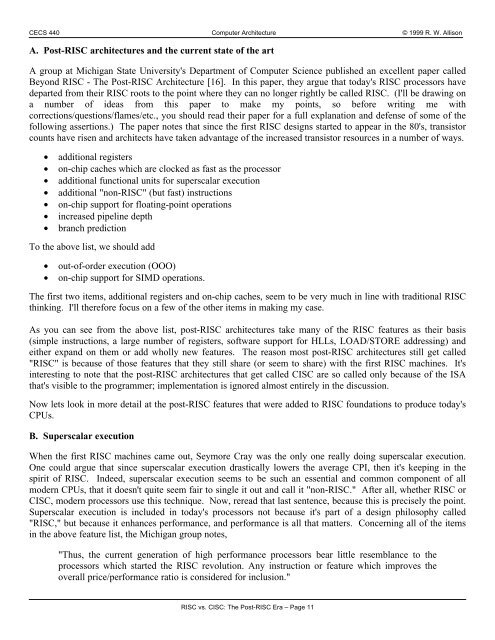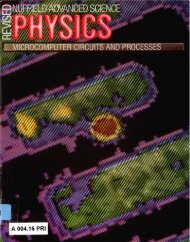RISC vs. CISC
RISC vs. CISC
RISC vs. CISC
Create successful ePaper yourself
Turn your PDF publications into a flip-book with our unique Google optimized e-Paper software.
CECS 440 Computer Architecture © 1999 R. W. Allison<br />
A. Post-<strong>RISC</strong> architectures and the current state of the art<br />
A group at Michigan State University's Department of Computer Science published an excellent paper called<br />
Beyond <strong>RISC</strong> - The Post-<strong>RISC</strong> Architecture [16]. In this paper, they argue that today's <strong>RISC</strong> processors have<br />
departed from their <strong>RISC</strong> roots to the point where they can no longer rightly be called <strong>RISC</strong>. (I'll be drawing on<br />
a number of ideas from this paper to make my points, so before writing me with<br />
corrections/questions/flames/etc., you should read their paper for a full explanation and defense of some of the<br />
following assertions.) The paper notes that since the first <strong>RISC</strong> designs started to appear in the 80's, transistor<br />
counts have risen and architects have taken advantage of the increased transistor resources in a number of ways.<br />
• additional registers<br />
• on-chip caches which are clocked as fast as the processor<br />
• additional functional units for superscalar execution<br />
• additional "non-<strong>RISC</strong>" (but fast) instructions<br />
• on-chip support for floating-point operations<br />
• increased pipeline depth<br />
• branch prediction<br />
To the above list, we should add<br />
• out-of-order execution (OOO)<br />
• on-chip support for SIMD operations.<br />
The first two items, additional registers and on-chip caches, seem to be very much in line with traditional <strong>RISC</strong><br />
thinking. I'll therefore focus on a few of the other items in making my case.<br />
As you can see from the above list, post-<strong>RISC</strong> architectures take many of the <strong>RISC</strong> features as their basis<br />
(simple instructions, a large number of registers, software support for HLLs, LOAD/STORE addressing) and<br />
either expand on them or add wholly new features. The reason most post-<strong>RISC</strong> architectures still get called<br />
"<strong>RISC</strong>" is because of those features that they still share (or seem to share) with the first <strong>RISC</strong> machines. It's<br />
interesting to note that the post-<strong>RISC</strong> architectures that get called <strong>CISC</strong> are so called only because of the ISA<br />
that's visible to the programmer; implementation is ignored almost entirely in the discussion.<br />
Now lets look in more detail at the post-<strong>RISC</strong> features that were added to <strong>RISC</strong> foundations to produce today's<br />
CPUs.<br />
B. Superscalar execution<br />
When the first <strong>RISC</strong> machines came out, Seymore Cray was the only one really doing superscalar execution.<br />
One could argue that since superscalar execution drastically lowers the average CPI, then it's keeping in the<br />
spirit of <strong>RISC</strong>. Indeed, superscalar execution seems to be such an essential and common component of all<br />
modern CPUs, that it doesn't quite seem fair to single it out and call it "non-<strong>RISC</strong>." After all, whether <strong>RISC</strong> or<br />
<strong>CISC</strong>, modern processors use this technique. Now, reread that last sentence, because this is precisely the point.<br />
Superscalar execution is included in today's processors not because it's part of a design philosophy called<br />
"<strong>RISC</strong>," but because it enhances performance, and performance is all that matters. Concerning all of the items<br />
in the above feature list, the Michigan group notes,<br />
"Thus, the current generation of high performance processors bear little resemblance to the<br />
processors which started the <strong>RISC</strong> revolution. Any instruction or feature which improves the<br />
overall price/performance ratio is considered for inclusion."<br />
<strong>RISC</strong> <strong>vs</strong>. <strong>CISC</strong>: The Post-<strong>RISC</strong> Era – Page 11











